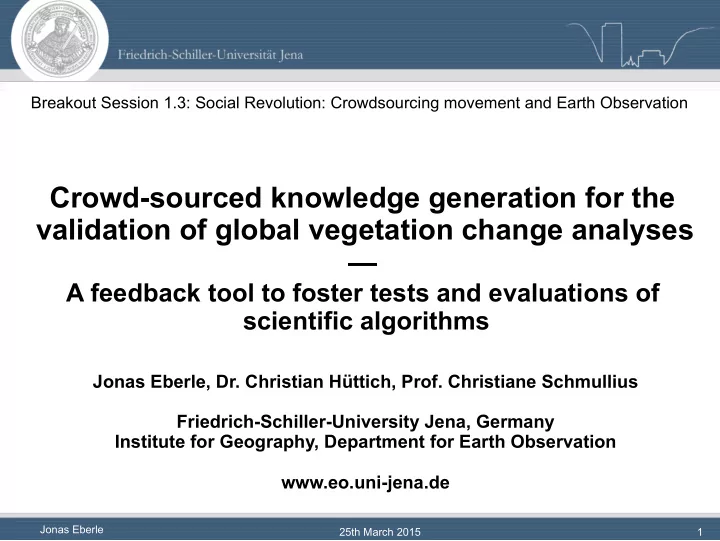

Breakout Session 1.3: Social Revolution: Crowdsourcing movement and Earth Observation Crowd-sourced knowledge generation for the validation of global vegetation change analyses — A feedback tool to foster tests and evaluations of scientific algorithms Jonas Eberle, Dr. Christian Hüttich, Prof. Christiane Schmullius Friedrich-Schiller-University Jena, Germany Institute for Geography, Department for Earth Observation www.eo.uni-jena.de Jonas Eberle 25th March 2015 1
Vegetation time-series change analyses • Data – MODIS Vegetation Index (NDVI, EVI) • 250m spatial resolution • 16-daily product • 14 years of data! • Analyses – Trend calculation – Break-point detection – Phenological parameters Jonas Eberle 25th March 2015 2
Vegetation trend calculation Greenbrown (R-package) Forkel et al. (2013). “Trend Change Detection in NDVI Time Series: Effects of Inter-Annual Variability and Methodology.” Remote Sensing 5 (5): 2113–44. • Example: – Use case: Anklam, Germany – Former moor area is being recultivated – Since 2008 controlled water logging • Web Service – OGC Web Processing Service – Inputs: data id + optional analysis parameters Jonas Eberle 25th March 2015 3
Vegetation break-point detection bfast (R-package) Verbesselt et al. (2010). “Detecting Trend and Seasonal Changes in Satellite Image Time Series.” Remote Sensing of Environment 114 (1). Elsevier B.V.: 106–15. • Web Service – Accessible via OGC Web Processing Service Center Lat.: 53.8328 – Inputs: data id + optional analysis parameters Center Long.: 13.8309 • Example: – Use case: Bavarian Forest – Bark beetle attack starting in the 90s à forest dieback – Now: greening on the ground Jonas Eberle 25th March 2015 4
Derivation of phenological parameters TIMESAT Jönsson & Eklundh (2004). “TIMESAT—a Program for Analyzing Time-Series of Satellite Sensor Data.” Computers & Geosciences 30 (8): 833–45. • Example – Use case: Anklam, Germany – Large Integral (mean) • Web Service – Accessible via OGC Web Processing Service – Inputs: data id + optional analysis parameters Jonas Eberle 25th March 2015 5
Crowd-sourced validation of analysis results • How can we evaluate algorithms in different regions for different aspects of change? • How can users easily explore algorithms without having any knowledge in data processing? Ø Automated data access linked with automated execution of analysis tools based on that data Ø Solutions: – Providing web services for data access and analysis – Developing easy to use clients Jonas Eberle 25th March 2015 6
Earth ¡Observa,on ¡Monitor ¡ Automated ¡access, ¡analysis, ¡and ¡monitoring ¡ of ¡global ¡vegeta6on ¡6me-‑series ¡data ¡ Datasets: ¡ ¡ MODIS ¡16-‑Daily ¡Vegeta2on ¡ • Index ¡(NDVI, ¡EVI) ¡ ¡ Data ¡access: ¡ • Pixel ¡or ¡Polygon-‑based ¡ extrac2on ¡service ¡ ¡ Analyses: ¡ ¡ • Trend ¡calcula2ons ¡ • Breakpoint ¡detec2on ¡ • Phenological ¡parameters ¡ ¡ Applica6ons: ¡ Web ¡Portal ¡ • Mobile ¡App ¡(mobileEOM) ¡ • for ¡iOS ¡and ¡Android ¡ www.earth-‑observa6on-‑monitor.net ¡
Crowd-sourced validation of analysis results Execute scientific algorithms with individual parameters around the world without the need to process any data Jonas Eberle 25th March 2015 8
Crowd-sourced validation of analysis results • Objectives – Help to improve & validate scientific algorithms – Give feedback / response to author of an algorithm – Easy to use! • Easy to use – User just needs to write a short description – Parameters used are automatically inserted into the text field Ø Online analysis feedback tool Jonas Eberle 25th March 2015 9
Analysis feedback tool • What do we want to achieve? – Interaction and exchange between users and authors of an algorithm – Better understanding of how useful the algorithm is for different regions / study areas – What are the needs of users using the algorithm? – Bringing scientific algorithms to operational services • What is needed? ü Data access ü Algorithm as web service o Feedback possibility (still to do) Jonas Eberle 25th March 2015 10
Analysis feedback tool • Implementation – Within the Earth Observation Monitor – Author of an algorithm needs to be involved – First algorithms to test feedback tool • Greenbrown trend calculations • bfast break-point detection – Results (will it be used?) • Further ideas – Discussing platform to communicate with other users – Add other datasets for validation of analysis results Jonas Eberle 25th March 2015 11
Satellite based Wetland Observation System (SWOS) • New 3-year EU H2020 project starting in June 2015 • Call: Making Earth Observation and Monitoring Data usable for ecosystem modelling and services • Objective: Development of an operational and standardized monitoring system for wetlands based on multi-sensor earth observation data. • Contributions to GEOSS are included in the project! • Crowd-sourcing with mobile devices – Validate wetland delineation on mobile device – Create new in situ data relevant for wetland processing & analysis Jonas Eberle 25th March 2015 12
Conclusions • Automated data access and web-based analysis tools have to be linked closely. • Analysis feedback tool still has to be implemented (next step) • More interaction between users and author of an algorithm • Algorithms can be tested everywhere around the world Ø Crowd-sourcing leads to new possibilities in – Testing algorithms – Evaluating algorithms – Exchanging experiences Ø We just need the right tools for users! Jonas Eberle 25th March 2015 13
Thank you for your attention! Questions? Contact information: Jonas Eberle Friedrich-Schiller-University Institute for Geography Department Earth Observation Loebdergraben 32 07743 Jena, Germany Acknowledgement: Friedrich-Schiller-University Jena and EU FP7 EuRuCAS phone: +49 3641 94 88 89 project (No. 295068) for financing work and travel. email: jonas.eberle@uni-jena.de Jonas Eberle 25th March 2015 14
Recommend
More recommend